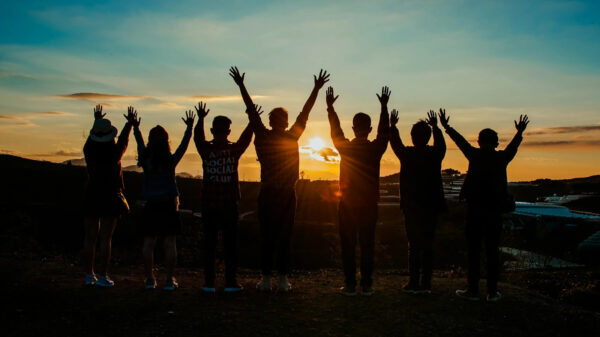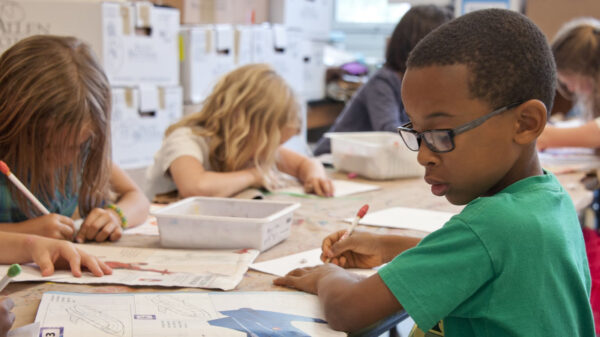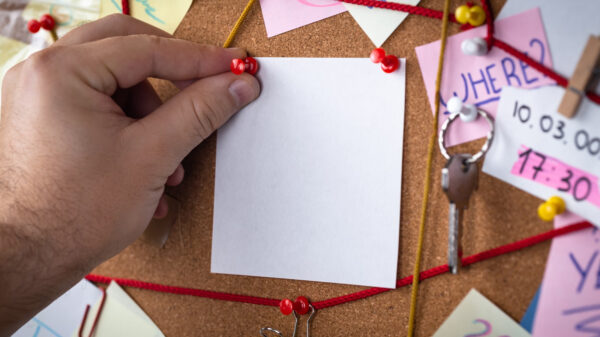
After twenty-five years spent handling evidence and investigating the truth (much of that time related to cold-case homicides), I’ve learned a few things about how we can investigate the Christian worldview and present it to those who have questions. There are a number of important parallels to be drawn between criminal investigations and examining the case for Christianity. In this post, I want to share eight steps I take in all my cold-case investigations. In my next post, I provide you with eight steps prosecutors take when presenting our cases. I hope there are a few valuable principles you can apply to your own investigation (and presentation) of Christianity. When I open a cold-case investigation, there are a number of steps I have to take before I can even begin to think about making a presentation to a jury. The process looks something like this:
STEP #1 – Read the Book Completely
I begin by pulling the original case book off the shelf. All our cold cases are bound in red notebooks and stored in a special vault. I start by selecting a case, opening the case book and reading through each and every word recorded in the notebook. The notebook contains the original crime reports the investigative summaries, original eyewitness interview transcripts, autopsy reports, crime scene investigation reports and everything else documented and collected at the time of the first investigation. Before I can do anything with this case, I need to read and understand the case book as though I was part of the original investigation. This can sometimes be very interesting, but it can also be quite boring. I’ve got to be diligent here, and it helps to try to “place myself” in the original investigation. I need to understand everything the original detectives were going through, what they were thinking and the nature of the culture at the time of the crime.
As a Christian…
I’ve got to do something very similar if I want to be a “Case Making” Christian. Before I can hope to make a case for the Christian Worldview, I better open the “book” (the Bible) and become intimately familiar with what it teaches. I’m going to need to read the original eyewitness transcripts (the Gospels) until I know them thoroughly. I’ve got to do my best to “place myself” at the scene and understand what the writers were writing from their perspective. This might require me to study history or geography to better understand the culture and how the original eyewitnesses thought so I can better understand their statements.
A “Case Making” Tip:
Read through the Biblical text in large sections over a short period of time. There are a number of reading plans to guide you through the Bible in a year, with selected readings from the Old Testament, New Testament and Psalms. If you read through the Bible in this way, you’ll never understand the flow and context of the eyewitness statements found in the scripture. Read sequentially through complete books of the Bible in as few sittings as possible. I take this same approach when reading the original case book. I may refer back and forth along the way, but I read the book “cover to cover” to get the broad scope prior to dissecting it. Proper Biblical “hermeneutics” are critically important. There are many good books that can help you understand how to properly read the Bible.
STEP #2 – Take Notes and Summarize the Case Thoroughly
Before I begin reading the original case book, I make a copy of it. I do this so I can highlight the pages of the book and write copious notes in the margins. I generally use colored pens, correlating a particular set of issues to a specific color. This helps me to think through the case more clearly and it reminds me of those areas needing clarification (or further investigation). It also provides me with a way to form my own summary of the important elements of the case. I usually then write outlines of the important details in my own personal notes.
As a Christian…
I’ve got to do something very similar if I want to be a “Case Making” Christian. I’ve purchased a number of inexpensive “pew Bibles” over the years with the largest possible margins on each page. I treat these Bibles like case books; I highlight them and write extensive notes with colored pens. I’ll even write extensive summaries in the blank pages of the Bibles (usually the title pages or the pages at the front or rear of the text). These notes have been incredibly powerful for me. I often remember theological issues in my “mind’s eye” by recalling which side of the page I originally scribbled a related note. These Bibles, with their notes and summaries, are organized on my shelf for future reference.
A “Case Making” Tip:
On your first review of the text, feel free to note everything you are discovering. Include your rational and emotional impressions, reminders of things you want to research, and places where the text offers something causing you to be skeptical. In this “first pass”, consider your notes a “mind dump” allowing you the freedom to chronicle everything you are seeing and feeling. Also, try to take notes and write your summaries in the Bible you are reading, rather than on additional pads of paper. These notes will then be “married to the text” and easier to find later.
STEP #3 – Gather the Evidence Neutrally
As I am reading through the original case book of a cold-case Homicide and taking thorough notes, I begin to organize, list and summarize the evidence available to the original investigators. At this point in the process, I refuse to come to any conclusions about what the evidence is telling me. Instead, I simply circle each place in the case where a piece of evidence is described and make a list of everything. Even though the first investigators may have begun to form a conclusion about the identity of the suspect, I do my best to keep an open mind at this point in the investigation. I want to make sure I see things the original detectives might have missed. I am simply collecting data at this early stage of the research.
As a Christian…
I’ve got to do something very similar if I want to be a “Case Making” Christian. The Bible gives us a number of clues and proofs to support its claims. As I study the text, I write out and list the evidences as they present themselves, trying to retain my skepticism in this process; like my examination of the original cold case book, I want to understand what the original writers believed while allowing for the possibility they were wrong. If we hope to present our case someday to a jury of our peers, we need to account for all the evidence, whether it supports the Christian claim clearly or otherwise.
A “Case Making” Tip:
You may want to purchase another inexpensive Bible for this stage of the investigation. You are now ready to create “evidence lists” related to each claim of Christianity. Some evidences are important to making a case for the Deity of Jesus, others are more important to making a case for the nature of God, others still are more important to making a case for the creation of the universe from nothing (“ex-nihilo”). Again, use the blank pages of the Bible to make these lists; color code them and use the same colors as you highlight the evidences in the text of the Bible. Begin to focus in this stage of the investigation. Your “evidence notes” should be limited to the specific claims you are investigating, and they must include all the evidence available, even if this evidence tends to make a case against a presupposition you hold. Remember you are trying to gather evidence without bias. You may want to have separate Bibles containing separate kinds of evidence lists. There are also a number of “evidence” study Bibles on the market to help you form basic lists.
STEP #4 – Examine the Eyewitnesses Critically
Our cold-case books are filled with interview transcripts from eyewitnesses at the time of the initial investigation. The eyewitness statements are incredibly important and they seldom agree with each other completely. The variations between eyewitness accounts is not troubling in and of itself. No two eyewitnesses see the same event in precisely the same way. But as an investigator, I’ve got to make sure the eyewitnesses are reliable. Are they motivated to lie for some reason? Did they have any pre-existing biases that influenced the way they saw the event? Where were they when the event occurred; were they really present at the time of the crime and did they have a clear view of what happened? As the detective in this case, I’m going to have to critically assess each eyewitness to make sure they are reliable before I begin to build a case on what they offer.
As a Christian…
I’ve got to do something very similar if I want to be a “Case Making” Christian. I’ve got to critically examine the eyewitnesses who observed Jesus’ life, death and resurrection. I need to recognize there are three eyewitness accounts in the Bible (Matthew, Mark and John) and recognize these accounts differ. Do they contradict one another? Can the differences be reconciled and can they be explained on the basis of perspective or literary purpose?
A “Case Making” Tip:
Begin this process by isolating the Gospels of Mark, Matthew and John. Read through each account, flipping back and forth to compare the events as they are described by all three authors. Matthew and Mark often agree precisely on the details of events, John often adds something previously omitted. As you compare the accounts, highlight and note the differences. Now examine these differences carefully. Can they be harmonized? Are they truly contradictory? Can perspective or literary purpose explain the differences?
STEP #5 – Reconstruct the Crime Scene (and Events) Meticulously
The cold-case book will also usually include a crime scene diagram and photographs of the scene. The crime scene alone can tell us a great deal about the victim and the killer. Cases that have few original photographs or lack a diagram are more difficult to work. In addition to this, every homicide is a chronology of events leading up to a murder. It’s my job to try to retrace the last days of the victim to get a better idea of how the victim came into contact with the murderer, or to see what caused the murder to occur in the first place. Something happened in the life of the victim over time, bringing the victim into danger. Reconstructing the final days of the victim’s life will tell me a great deal about the victim and the circumstances leading to the victim’s death.
As a Christian…
I’ve got to do something very similar if I want to be a “Case Making” Christian. The Bible is more than a book containing spiritual truth, it is a book of history including real geographic locations (many of which still exist today or have been located by archeologists). We can now “reconstruct” the geography of ancient Palestine to help us understand the events recorded in Scripture. In addition, I can recreate the timeline of events leading up to the birth of Jesus. I can also reconstruct the timeline of his ministry leading up to the crucifixion. The chronological reconstruction can help us to see the role successive prophecy played in predicting Jesus’ life and role as Savior, and the geographical reconstruction can help to confirm (or erode) the reliability of the eyewitness accounts of the Gospels.
A “Case Making” Tip:
Divide this portion of your study into two categories of inquiry. First, what is the prophetic timeline running through the Old Testament preceding the appearance of Jesus? I’ve written about the prophecies predicting Jesus’ birth, life, ministry, death and resurrection. This prophetic chronology is strong evidence for both the divine inspiration of the Bible and the Deity of Jesus. Next, examine the “crime scene” by evaluating the archeological support for the Old and New Testament. In addition to the articles that I’ve written, there are a number of good books describing the archeological confirmation of the Bible.
STEP #6 – Look for New Evidence Diligently
Every cold-case goes cold for a reason. Typically it’s because the evidence was insufficient at the time of the first investigation. While this evidence might have pointed to a particular conclusion or toward a particular suspect, the first investigators and prosecutors simply did not believe the evidence was sufficient enough to convince a jury. The new cold case investigation must, therefore, begin looking for additional evidence to strengthen the case. The passage of time often helps us to identify and recover new evidence. Sometimes new technology allows us to examine old evidence in a new way. Sometimes hesitant eyewitnesses are now willing to discuss what they saw. Regardless of the nature of the new evidence, it’s important for me, as the detective who is now in charge of the case, to begin diligently searching for something new to strengthen the existing case. This new piece of evidence may come from inside the original case book, or it may come from a creative approach previously unconsidered by the first detectives.
As a Christian…
I’ve got to do something very similar if I want to be a “Case Making” Christian. I’ve got to step outside the Biblical pages and look for evidence outside the Scripture. While most Christians are familiar with the Biblical texts, few look at them evidentially (examining them from the perspective of fulfilled prophecy, confirmed archeology or scientific accuracy). Even fewer Christians are familiar with the writings of non-Christians and Jewish authors of the first century. Many of these authors provide corroborating texts useful in building the case for (or against) Christianity.
A “Case Making” Tip:
Begin collecting resources describing the first century non-biblical sources who write about Jesus or the early Christians. Become familiar with the writing of Thallus, Pliny the Younger, Suetonius, Tacitus, Mara Bar-Serapion, Phlegon, Josephus and others. If you can’t afford to buy these resources and place them on your shelf, begin to bookmark the websites containing information related to these writers. Many of these websites are printable. When I first started my research (before I was able to purchase source documents) I printed a number of these sites and bound the materials in notebooks on my shelf for future reference.
STEP #7 – Reason Toward An Answer Rationally
There comes a time in every Cold Case investigation, when the detectives have to move beyond the neutral collection of evidence. There comes a time when the investigators need to interpret and assess the evidence to determine what it all means. Does the evidence point to a particular suspect, and how do I determine WHICH suspect best accounts for the evidence I have? When evaluating the evidence on any homicide, I employ five reasoning principles in order to determine the identity of the suspect (I’ve written about these more extensively in Cold-Case Christianity):
The truth must be “feasible”
(The explanation has explanatory viability)
Before I even begin to think about the evidence related to a particular murder suspect, I need to make sure he or she was available to commit the crime in the first place. I investigate the alibis of potential suspects, eliminating those who are simply impossibilities based on confirmed alibis.
The truth will usually be “straightforward”
(The explanation demonstrates explanatory simplicity)
When considering a number of suspects, I look for the man or woman who most simply accounts for the evidence. If one person can account for the evidence (rather than some theory requiring three or four different potential suspects to account for the same evidence), he or she is most likely the killer.
The truth should be “exhaustive”
(The explanation displays explanatory depth)
I also consider the suspect who most exhaustively explains the evidence I have in a case. While a particular suspect may explain one, two, or three pieces of evidence, the suspect who accounts for most (or all) of the evidence is typically the killer.
The truth must be “logical”
(The explanation possesses explanatory consistency)
The truth is rational; for this reason the truth about the identity of my killer must also make sense. Suspects commit murders for reasons of one kind or another, even if these reasons seem insufficient to you and me. The true killer will make sense to the jury once they understand his or her misguided motivation. Conversely, some candidates will appear logically inconsistent because they lack motive altogether.
The truth will be “superior”
(The explanation achieves explanatory superiority)
Finally, I recognize one of my suspects is unique in the superior way he or she accounts for the evidence. In essence, this particular suspect is a far better choice when compared to other candidates who are offered. The quality of his or her connection to the evidence is better. When I see this characteristic of explanatory superiority, I know I have my killer.
Given these five criteria, I evaluate all the evidence and come to a conclusion regarding the identity of the killer. There comes a time when I have to focus in on one reasonable conclusion about the case, and these five explanatory criteria help me to determine the truth about the identity of the killer.
As a Christian…
I’ve got to do something very similar if I want to be a “Case Making” Christian. The three basic evidential principles of reasoning can be applied to the Biblical evidence. Most scholars, for example, will agree on several minimal facts related to the claim of the Resurrection (even if they don’t agree that Jesus was actually resurrected from the dead). Most scholars agree Jesus died on a cross, a belief in the resurrection appeared very soon after the time of Jesus’ death, the disciples claimed to see Jesus resurrected, both Paul and James were transformed and said this was the result of seeing the resurrected Jesus, and the apostles all died a martyr’s death rather than recant their claims related to the resurrection. How are we to explain or account for these commonly agreed upon pieces of evidence? It may be a number of coincidental circumstances aligned to cause these facts to emerge. For example, Jesus may not have died, or he may have been stolen from the grave; someone may have pretended to be Jesus or the disciples may have conspired to create the story; the disciples may have hallucinated the resurrection or resuscitated the wounded Jesus to fake the resurrection. These possibilities would require an elaborate web of conspiracy, trickery and unreasonable self-sacrifice to support the lie, but we would have to admit one of these complex scenarios is at least “possible”. On the other hand, a simpler explanation could be offered: Jesus simply rose from the dead. If the simpler explanation is to be trusted, we must conclude that the resurrection of Christ is the most reasonable solution.
A “Case Making” Tip:
I’ve applied this approach to the Resurrection through the filter of “abductive reasoning” in ALIVE: A Cold-Case Approach to the Resurrection. Many gifted historians and scholars have utilized similar principles of evidence to make a case for historic Christianity. One of the best examples of this approach is found in the work of Gary Habermas and Michael Licona. Their example of creating a list of commonly accepted evidences related to the resurrection and then reasoning toward the best explanation is instructive and powerful. Read through their example and apply similar strategies to other claims in the Bible.
STEP #8 – Write Up the Case Carefully
Once I’ve narrowed my focus and come to a conclusion about the identity of my killer, it’s time to present what I know to others (particularly to the District Attorney who has to decide if there is enough evidence to make an arrest and prosecute the killer). Now’s the time to begin writing down what I know; the time to make a case on paper by laying out all the evidence and demonstrating how this evidence points singularly to the suspect I want to arrest. This process of summarizing and organizing the case is extremely helpful. In addition to making it possible to present the case to others, it helps me understand and clarify my own thinking about the evidence and what it demonstrates.
As a Christian…
I’ve got to do something very similar if I want to be a “Case Making” Christian. It’s sometimes hard to grasp deep theological concepts and draw conclusions about where the evidence leads. It’s always helpful to write out or journal my observations, creating summaries and shorthand arguments I can then use in the future when reviewing the issue again. The act of concisely summarizing my findings has great value in critically thinking through the evidence and forming rational conclusions that can then be expressed to others.
A “Case Making” Tip:
Take the time to create evidential “cases” related to the issues concerning you the most. Write these cases out in some format so they can be saved and stored in a place where you can access them quickly later. For me, the best and most logical location for these “case notes” was my Bible. That’s why I designed my case summaries as half-sheet Bible Inserts. I’ve provided a number of these free downloadable Bible Inserts on the homepage at ColdCaseChristainity.com.
Once an investigation culminates with a decision about the involvement of a particular suspect (and results in the arrest of this suspect), we’ve next got to present our case in a court of law. The burden begins to shift from the detective to the attorneys who then take nine steps to make the case. Becoming a “Case Making” Christian means applying the basic rules of investigation and presentation to every aspect of the Christian Life. Share on X
Becoming a “Case Making” Christian means applying the basic rules of investigation and presentation to every aspect of the Christian Life. Why do you believe a particular Christian Doctrine? Have you applied good investigative techniques to your view? Are you able to present your view to others? Why do you behave in a particular way? Have you investigated the foundational belief guiding your behavior? Are you able to defend this belief on the basis of Biblical evidence? Christian “Case Making” is not simply an approach to Christian apologetics; it’s an approach to Christian living. Christian “Case Makers” refuse to live unexamined lives; they understand the value of rationality and good philosophy. As a result, Christian “Case Making” raises the bar on thoughtful living. God has created us in his image and given us the capacity to live beyond our natural impulses and desires. He’s given us the ability to dream and reason; the ability to exceed our own natural limits. Let’s use what God has given us to make the case for the Christian Worldview.

J. Warner Wallace is a Dateline featured Cold-Case Detective, Senior Fellow at the Colson Center for Christian Worldview, Adj. Professor of Christian Apologetics at Talbot School of Theology, Biola University, author of Cold-Case Christianity, God’s Crime Scene, and Forensic Faith, and creator of the Case Makers Academy for kids.
Subscribe to J. Warner’s Daily Email
J. Warner Wallace is a Dateline featured cold-case homicide detective, popular national speaker and best-selling author. He continues to consult on cold-case investigations while serving as a Senior Fellow at the Colson Center for Christian Worldview. He is also an Adj. Professor of Christian Apologetics at Talbot School of Theology, Biola University, and a faculty member at Summit Ministries. He holds a BA in Design (from CSULB), an MA in Architecture (from UCLA), and an MA in Theological Studies (from Gateway Seminary).

































Pingback: Nine Steps to Presenting the Case for Christianity | Cold Case Christianity
Pingback: Nine Steps to Presenting the Case for Christianity | Apologetics ForumApologetics Forum
Pingback: Three Simple Strategies to Help You Become A Better Christian Case Maker | Cold Case Christianity
Pingback: Why Making a Case for the Bible Is More Important Than Arguing About Politics | Apologetics.com
Pingback: Why Making a Case for the Bible Is More Important Than Arguing About Politics | TLG Christian News
Pingback: 121 Quotes on Why We Need Apologetics - The Poached Egg Christian Worldview and Apologetics Network
Pingback: Weekly Apologetics Bonus Links 6/16-22 | Apologetics315
Pingback: Three Simple Rules for Apologetics Multimedia Presentations – Apologetics Ministry
Pingback: How Are We to Reconcile Natural and Special Revelation? - Nehemiah Reset
Pingback: What to Look For When You're Taking Notes During a Bible Study - Nehemiah Reset